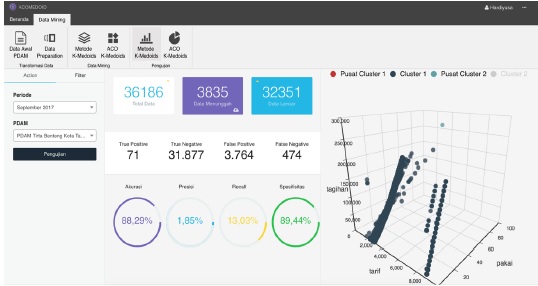HR Potensi Pelanggan Tunggakan PDAM Menggunakan Metode K-Medoids dengan Optimasi Ant Colony Optimization (ACO)
Abstract
PDAM in carrying out operational activities is greatly influenced by the receivables or arrears of customer water bills. Some factors that influence customer patterns in delinquent water bills are customer class and consumption of water usage, which affects the water bill paid by the customer. This study will apply the K-Medoids clustering method to find out customers who are delinquent in the PDAM by optimizing the selection of cluster centers using the Ant Colony Optimization (ACO) algorithm. In this study the combination of ACO and K-Medoids methods is called ACOMedoids. The results with the ACOMedoids method can produce a high level of accuracy from the comparison of clustering data with actual bill data. This can be seen from the results of accuracy which is always better than the K-Medoids method, which is the highest achieves 97.65% accuracy for ACOMedoids while K-Medoids is 88.29%. Accuracy results show that the ACO algorithm can produce optimal cluster center points in the clustering process of the K-Medoids method.
Downloads
References
[2] C. Laspidou, et all. “Exploring Patterns In Water Consumption By Clustering” Elsevier: Procedia Engineering 13th Computer Control for Water Industry Conference, CCWI, 2015, 119:1439-1446.
[3] S. Moedjiono, F. Fransisca and A. Kusdaryono. “Segmentation and Classification Customer Payment Behavior at Multimedia Service Provider Company with K-Means and C4.5 Algorithm” International Journal of Computer Networks and Communications Security, Vol. 4, No. 9:265–275, 2015.
[4] K. Dahiya, S. Bhatia, “Customer Churn Analysis in Telecom Industry” IEEE 4th International Conference on Reliability, Infocom Technologies and Optimization (ICRITO) (Trends and Future Directions), 2-4 Sept. 2015.
[5] A. J. Hamid and T. M. Ahmed. “Developing Prediction Model Of Loan Risk In Banks Using Data Mining” Machine Learning and Applications: An International Journal (MLAIJ), Vol.3, No.1, 2016.
[6] M. Sood and S. Bansal, “K-Medoids Clustering Technique using Bat Algorithm” International Journal of Advanced Research in Computer Science and Software Engineering, 2013, Vol.5, No.8:20-22.
[7] R. Hadi, I K. G. D. Putra dan I N. S. Kumara, “Penentuan Kompetensi Mahasiswa Dengan Algoritma Genetik Dan Metode Fuzzy C-Means”, Majalah Ilmiah Teknologi Elektro, Vol. 15, No. 2, Juli - Desember 2016.
[8] P. Suwirmayanti, I K. G. D. Putra dan I N. S. Kumara, “Optimasi Pusat Cluster K-Prototype Dengan Algoritma Genetika”, Majalah Ilmiah Teknologi Elektro, Vol. 13, No. 2, Juli - Desember 2014.
[9] M. Dorigo, L. M. Gambardella, “Ant Colony System: A Cooperative Learning Approach to the Traveling Salesman Problem”, IEEE Transactions on Evolutionary Computation, 1:53-56, 1997.
[10] M. Dorigo, T. Stutzle, Ant Colony Optimization. London: A Bradford Book The MIT Press, 2004.
[11] J. Han, M. Kamber, Data mining: Concept and Techniques second edition. USA: Elsevier Inc, 2006.
[12] F. Gorunescu, Data mining Concepts, Models and Techniques. Romania: Springer-Verlag Berlin Heidelberg, 2011.


This work is licensed under a Creative Commons Attribution-NonCommercial-NoDerivatives 4.0 International License.

This work is licensed under a Creative Commons Attribution 4.0 International License




